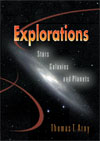On a clear, moonless night, far from city lights, you can see a pale band of
light spangled with stars stretching across the sky (fig. 9.1). The ancient
Hindus thought this shimmering river of light in the heavens was the source
of the sacred river Ganges. To the ancient Greeks, this dim celestial glow looked
like milk spilt across the night sky, and so they called it the Milky Way. In
the seventeenth century, Galileo showed that the Milky Way is millions of stars
too dim to be seen as individual points of light. Now, in the twenty-first century,
we know that these stars, along with our Sun, form a huge, slowly revolving
disk--our galaxy. The word galaxy itself comes from the ancient Greeks and their
word for "milk"galactos. Thus, "Milky Way" is both the name
of the band of light across the night sky and the name of our galaxy. A view of the Milky Way on a clear, dark night is one of nature's finest spectacles.
Superposed on the dim background glow are most of the bright stars and star
clusters that we can see, which all belong to our galaxy. Here and there, however,
dark blotches interrupt the glowing backdrop of stars, as you can see in figure
9.2. Ancient Incan astronomers observing the Milky Way from their temple observatories
in the Andes gave these dark areas names, just as peoples of the classical world
named the star groups. Today, we know the dark regions are clouds of dust and
gas that give birth to new stars, as we discussed in chapter 7. |



 2002 McGraw-Hill Higher Education
2002 McGraw-Hill Higher Education